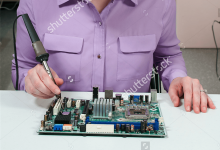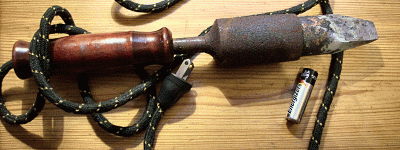Don't ever get old...lol My hands shake a little bit from exposure to Agent Orange, Some days not at all and others a little more.
I have been trying to come up with some mechanical device to assist in soldering small surface mount components.
I have both optical and digital microscopes.
Any ideas for an old guy like me.
Thanks,
Billy
I have been trying to come up with some mechanical device to assist in soldering small surface mount components.
I have both optical and digital microscopes.
Any ideas for an old guy like me.
Thanks,
Billy
Aging certainly is a bummer! I did a lot of work with Atlas Copco Tools regarding ergonomics - mainly production lines. It is most important to support as much of your arms as practicable; probably right up to the wrists in your case so that any arm movements have minimal effect. A heavier or weighted soldering iron, though more tiring, would also show less movement. Good luck.
+1 on supporting arm-hand as much as possible, near board or whatever is being soldered, and reducing "degrees of freedom" only to fingers.
Reduces problem by 90-95% ,literally.
Basic Geometry 101
+ using "visual amplification" he he.
Regular reading glasses power is +2 ... to read abook that is, but for minute soldering work I use +4, turning them into loupes.
+ a standard jeweller´s loupe for real close up soldering defects inspection, finding burrs in my self made PCBs, tiny solder bridges or "whiskers", etc.
Reduces problem by 90-95% ,literally.
Basic Geometry 101
+ using "visual amplification" he he.
Regular reading glasses power is +2 ... to read abook that is, but for minute soldering work I use +4, turning them into loupes.
+ a standard jeweller´s loupe for real close up soldering defects inspection, finding burrs in my self made PCBs, tiny solder bridges or "whiskers", etc.
I'll guess you have some nice flat surfaces around? Hold the soldering iron in a fixture, move the work underneath it secured to another fixture?
Make a bladder controlled pop-up feature on the work fixture, that you can operate using a bulb under your foot? So you slide it from position to position around the surface, then when it's in just the right spot, raise it to contact the soldering iron tip.
Otherwise its time to employ a board house that does BOM and build. I asked a tech, a couple years older than me, how he manages to work with - even see - such small component sizes. He laughed and said "I aim between the blurs".
Make a bladder controlled pop-up feature on the work fixture, that you can operate using a bulb under your foot? So you slide it from position to position around the surface, then when it's in just the right spot, raise it to contact the soldering iron tip.
Otherwise its time to employ a board house that does BOM and build. I asked a tech, a couple years older than me, how he manages to work with - even see - such small component sizes. He laughed and said "I aim between the blurs".
My first technique is to try not to use components smaller than 1210 size. I do use one IC with .025” lead spacing. I can run a bead of solder to get all the pins at once. Then I use solder wick to remove the excess. Enough solder stays under the leads to connect everything.
Then there is the small glass of wine to reduce tremors.
Standard practice is to put a drop of solder on one pad and then resting my wrist on the bench and using tweezers to move the part into place and securing it with the soldering iron. If it isn’t quite right reheat and correct position with the tweezers. Typically mount all the resistors with just one side before finish soldering all of the second sides. That way I don’t have any problem removing parts that were in the wrong spot.
For ICs I mount one leg first and get it straight. Once down correctly I then finish the other side first. .050” I do one lead at a time using solder wick to correct any blobs. Finer pitch I just run a bead and remove the excess.
Of course .010” diameter solder and the smallest tip for the soldering iron.
One more important tip. Always try to hold the soldering iron by the cool end.
Then there is the small glass of wine to reduce tremors.
Standard practice is to put a drop of solder on one pad and then resting my wrist on the bench and using tweezers to move the part into place and securing it with the soldering iron. If it isn’t quite right reheat and correct position with the tweezers. Typically mount all the resistors with just one side before finish soldering all of the second sides. That way I don’t have any problem removing parts that were in the wrong spot.
For ICs I mount one leg first and get it straight. Once down correctly I then finish the other side first. .050” I do one lead at a time using solder wick to correct any blobs. Finer pitch I just run a bead and remove the excess.
Of course .010” diameter solder and the smallest tip for the soldering iron.
One more important tip. Always try to hold the soldering iron by the cool end.
Last edited:
I feel your pain  . My hands also shake problematically. I use an arm rest, and exhale while soldering. The exhalation helps a lot. Have a look for a "setter's arm rest":
. My hands also shake problematically. I use an arm rest, and exhale while soldering. The exhalation helps a lot. Have a look for a "setter's arm rest":
Ergorest 330-Series Long Articulating Arm Rest 330-013 B&H Photo
Bench Clamp On Setters Arm Rest | OttoFrei.com
edit: the newer cartridge-style irons allow a grip much closer to the tip, which is also a huge benefit
Ergorest 330-Series Long Articulating Arm Rest 330-013 B&H Photo
Bench Clamp On Setters Arm Rest | OttoFrei.com
edit: the newer cartridge-style irons allow a grip much closer to the tip, which is also a huge benefit
Last edited:
An important first step is to pick it up at the right end.
Attachments
Thanks for all the feedback. I got a little board with a bunch of parts to try on.
Actually things went better than I expected. Standard size iron, smallest tip I could find, Isopropyl alcohol to clean the board, Kester 2331-ZX Flux Pen, Kester 0.4mm 63/37 3.33% 370C.
I was able to manage down to 0402 with digital microscope which is difficult for me to use but I think I can get use to it.
I have built a lot of tube guitar amps but this solid state world is new to me to began with. All this surface mount stuff is going to take some time to get acquainted with. There are parts in this kit I don't recognize and are not marked. No schematic, typical made in China stuff.
Deep breathing with hand and wrist well braced did the job at least today. Sometimes the shaking and the PTSD get to having fun with my brain then all bets are off...lol
Not prefect but OK for a first try
 [/IMG]
[/IMG]
Actually things went better than I expected. Standard size iron, smallest tip I could find, Isopropyl alcohol to clean the board, Kester 2331-ZX Flux Pen, Kester 0.4mm 63/37 3.33% 370C.
I was able to manage down to 0402 with digital microscope which is difficult for me to use but I think I can get use to it.
I have built a lot of tube guitar amps but this solid state world is new to me to began with. All this surface mount stuff is going to take some time to get acquainted with. There are parts in this kit I don't recognize and are not marked. No schematic, typical made in China stuff.
Deep breathing with hand and wrist well braced did the job at least today. Sometimes the shaking and the PTSD get to having fun with my brain then all bets are off...lol
Not prefect but OK for a first try

Use an iron with a short grip-to-tip spacing. I use a Metcal, but there are probably cheaper options.
Some of the old Weller irons were horrible about this. Big, thick handle and about 4" from the grip to the tip. One cup of tea is enough to make soldering with one of those nearly impossible. By contrast, I can solder "adequately" with a Metcal even after five cups of tea. Well, at least until someone wacks me over the head with a baseball bat to try and get me to shut up.
Some of the old Weller irons were horrible about this. Big, thick handle and about 4" from the grip to the tip. One cup of tea is enough to make soldering with one of those nearly impossible. By contrast, I can solder "adequately" with a Metcal even after five cups of tea. Well, at least until someone wacks me over the head with a baseball bat to try and get me to shut up.
A Metcal is 5 cups of tea bether than an old Weller 
New soldering iron measuring unit?
Have a look at: Soldering MELF resistors with a soldering iron - YouTube
this is a decent way to do it in my opinion.
Regards
New soldering iron measuring unit?
Have a look at: Soldering MELF resistors with a soldering iron - YouTube
this is a decent way to do it in my opinion.
Regards
I have both optical and digital microscopes.
This will make it so much easier to solder smd and check the quality of the solder joints.
You'll get used it and you may find its less fiddly than bending, inserting and turning the board over to solder through hole components. Everything electronic is smd these days, through hole components are disappearing from manufacturers inventories and devices such as integrated circuits are increasingly being manufactured as smd only.All this surface mount stuff is going to take some time to get acquainted with.
Not prefect but OK for a first try
Considering the physical challenges you are facing the quality of your soldering is very good, I've seen seasoned electronic technicians do worse.
The photo is a bit blurry and from what I can see the 0402 and 0603 have been soldered very well, a little too much solder on the 0805 device, this maybe because the 0.4mm makes it a little difficult to control how much solder flows onto the pcb pad, a bit more practice and you'll get the hang of it. Smaller diameter solder helps in this regard as well. When you run out of solder, Kester has 0.25mm diameter types, this makes it easier to feed the solder without causing it to blob.
- Home
- General Interest
- Everything Else
- how to hold a soldering Iron steady

